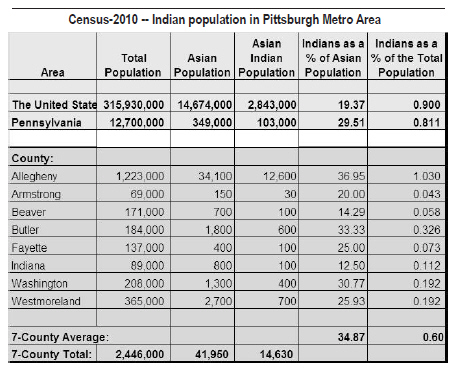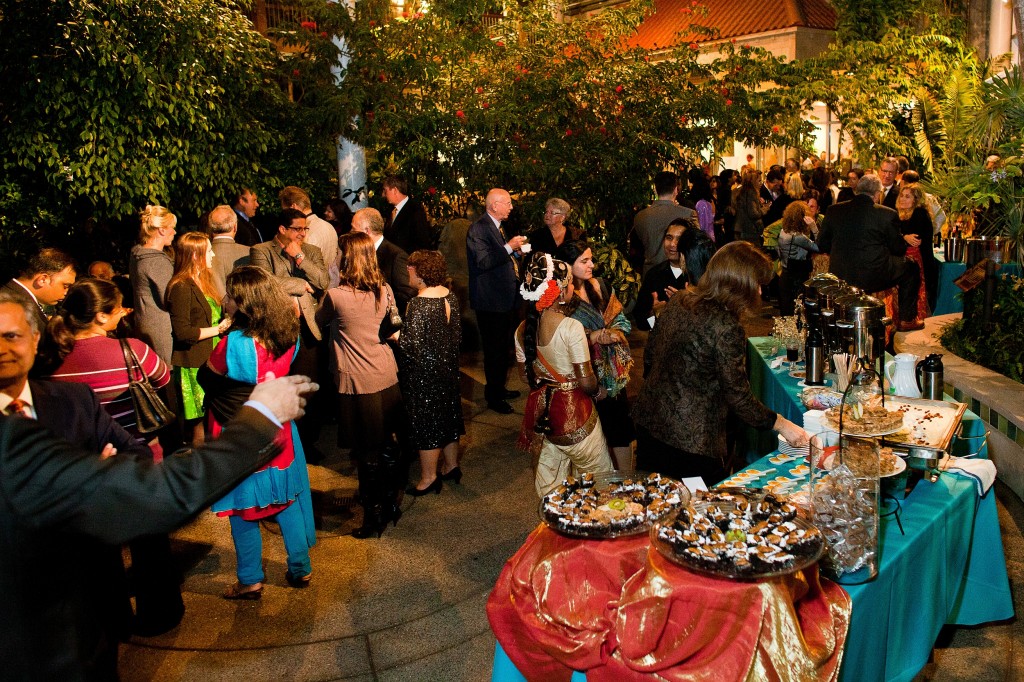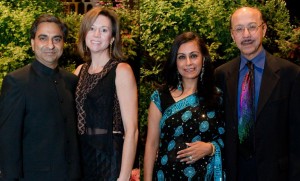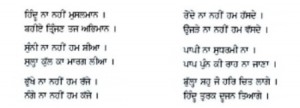Archive for category January 2012
Census-2010 Update on “Asian Indians†in Southwest Penna
Posted by admin in January 2012 on December 23, 2011
By Kollengode S Venkataraman
OK. The details of the 2010 US Census containing all kinds of data that can be summarized, parsed, sliced and diced in countless ways are now available online. Extracting the info you want, however, is another matter. You will need a coach — either a virtual one, or a person who can walk you through to navigate the site.
With help from Dr. Amitabha Das (amitabha.das@census.gov) at the US Census Bureau, I learned the basics of extracting data from the 2010-Census database.
In the October-2010 issue, I wrote an article titled “Counting Indian-Americans in Pittsburgh… …” giving the county-by-county numbers of the Indian population in the seven counties around Pittsburgh on the basis of Census-2000 data. The summary of my article was as below.
Allegheny County: 11,800
The remaining 6-counties combined: 2,600
Total: 14,400.
The Census-2000 did not identify Indian Americans as a separate demographic group. However, for Allegheny County it estimated that Indian-Americans are 41.1% of the total Asian population. I estimated the Indian population in the neighboring counties assuming that Indians make up 40% of the Asian population. The Census-2010 data suggest that this assumption was incorrect.
The 2010-Census counts Indian-Americans as a separate group, classifying them as Asian Indian. The table below gives the number for Asian Indians (or Indians) for the seven counties along with the numbers for the entire US and the commonwealth of Pennsylvania.
Several points are in order.
1. The Indian-American population in the US now stands at 2.84 million, accounting for 0.90% of the nation’s population. In Pennsylvania, the Indian population�in the�Census-2010 is�103,000, or 0.81% of the population. In the census in 2000, the Indian population in the state was 88,000, which was 0.713% of Pennsylvania’s popultion of 12 million then.
2. Indian-Americans, by and large, are very urban�– we are City Slickers. For example, 12,600 Indians are in Allegheny County (population 1.223 million with the City of Pittsburgh having over 300,000). But only 2000 Indians live in the seven neighboring counties (with a combined 7-county population of 1.2 million).
3. Â In Allegheny County, the Indian population icreased from 11,800 in 2000 t0 12,600 in 2010, which is a respectable 6.7% increase ofer the ten year period.
4. The 2010 Census numbers reveal that the Indian population as a % of the Asian population is not around 40%, the number I used in my earlier calculation, but much lower. While it is close in Allegheny County (37% of all Asians), in the remaining six counties, it is much lower: 12.5% (Indiana County), 25.9% (Westmoreland County), 33.3% (Butler County), and 30.8% (Washington County).
From the 2010 Census data shown in the table�above we can estimate that in the seven counties surrounding Allegheny County, Indian-Americans account for only 25.9% of the Asian population.
The Census-2010 data show that 12,600 Indian-Americans live in Allegheny County alone, and another 2000 of us live in the adjacent seven counties combined.
In these eight-counties, now 14,600 Indian-Americans call this region their home. �
Campaign Rhetoric in Kentucky — A Rite of Passage for American Hindus
Posted by admin in January 2012 on December 23, 2011
By Kollengode SÂ Venkataraman
“All is fair in love and war†is a clichéd adage, to which we can also add “in business too,†till one gets caught. David Williams, Kentucky’s Republican candidate for the governor’s race in last November crudely exemplifies this. Williams was trailing badly behind his Democratic incumbent opponent, Gov. Steve Beshear, who participated in a bhoomi pooja (ground-breaking ceremony) for a $180-million factory. The plant, to be built by an Indian-American Hindu entrepreneur, will directly employ 250 Kentuckians, giving jobs to another 750 people indirectly. Unemployment in Kentucky was 9.7% in November 2011.
Williams plastered all over the photo of Beshear participating in the Bhoomi Puja saying, “[Beshear] is there participating with Hindu priests, participating in a religious ceremony. He’s sitting down there with his legs crossed, participating in Hindu prayers with a dot on his forehead with incense burning around him. I don’t know what the man was thinking.†He added this gem: “I think you disrespect other people’s religion when you go down there [to their places of worship].†A detailed report is here:
 http://www.kentucky.com/2011/11/01/1943049/williams-blasts-beshear-for-participating.html
Using Williams’ twisted logic, all non-Christians who have participated in Christian weddings sitting in the pews of churches uttering “amen†along with others, or have gone to the Christian funeral services, have disrespected Christianity.
Before one reacts to William’s bigoted view towards the Hindu religion, one needs to understand the history of this nation. Even decades after the Civil War, the attitude of the powerful white American Protestant establishment towards Blacks, and Jews & Catholic immigrants from Europe was along similar lines. After a period of considerable soul-searching, the Protestant establishment reconciled the different faiths under the rubric of “Judeo-Christian†heritage, which seems to work fine for the most part. Post 9-11, the American establishment tries to reconcile with Muslims with the inclusive phrase “Abrahamic faiths.†But reconciliation is too far away. Where do the agnostic Buddhists, atheistic Jains, monist Sikhs and the “idolatrous†Hindus fit into this? Given the history of the internecine wars among the Abrahamics, many non-Abrahmics may think, “Leave us alone.†You may wonder why? There are reasons:
Here is the attitude of 4th century Syrian-born Christian Theologian Saint Ephrem, who composed a hymn in Syriac in praise of his faith that is racist by today’s norms (Ref: All is Change – The Two-Thousand-Year Journey of Buddhism to the West by Lawrence Sutin, p. 31, Little, Brown and Company, New York (2006)). Translation below:
The sun-burnt India you [that is, Christianity] have made fair…
A tainted land of dark people, you [Christianity] have purified.
More than snow and white linen
The dark bride of India, you [Christianity] have made fair… …
The crown of light has obliterated India’s darkness shades.
During the Colonial days in India over a millennia later, the attitude of the newly landed European Christian missionaries towards Hindus was worse. The European missionaries were dictating to Hindus what was right in matters of faith without even caring to know the Indian spiritual ethos. Francis Xavier (1506 – 1552), later canonized as St. Xavier, representing the Vatican in India, was responsible for unleashing the Inquisition of Hindus in Goa with support from the Portuguese rulers, similar to inquisition of Jews and Muslims in Portugal. Search the web for Goa Inquisition for more details. Incidentally, the fashionable, upscale St. Xavier’s College in Mumbai where Mumbai’s elite Hindus send their sons and daughters, is named after the same inquisitor St. Xavier. Â
Let us also not overlook the behavior of elected officials of our own ilk in the US. Louisiana governor Bobby (Piyush) Jindal (R) did not even want to be seen in the White House Deepavali where nobody had to sit cross-legged on the floor. South Carolina’s Nikki Haley (R) walked away from her Sikh/Hindu heritage to get elected as governor. Luckily, we have Dalip Singh Saund (D) (1899-1973) for inspiration. He did not change his name and his faith –- he was a Sikh — and yet got elected to the US Congress from California in 1956 under even harsher environment.
Given this history, how should the Hindus in the US respond to the Republican and Protestant David Williams’ diatribe against the Hindu faith? First, let us appeal to Yahveh Himself, paraphrasing the words of His only Son: “Forgive Dave, O Lord, for he knows not what he says. He is swirling in blind faith, ignorance, and prejudice.†Yahveh just might forgive Williams. But Kentuckians did not. Williams lost big time to Beshear in the election — 56% to 35%. In his victory speech, Beshear was candid: “In the election, we asked voters to send a strong message against … … the politics of religious intolerance. Today, they sent the message in the strongest possible terms.†Amen, Governor Beshear!
Williams is not the only one in this genre. Republican Governor Robert J. Bentley of Alabama last January said this after taking office: “Anybody here today who has not accepted Jesus Christ as their savior, I’m telling you, you’re not my brother.†(Ref: “Southern Hospitality, but Not for Newcomers,†Opinion piece by Yunte Huang, NY Times, November 19, 2011). Mercifully, later Bentley apologized for his statement.Â
We are likely to have more Williams and Bentleys in the years ahead. But taking inspiration from the Black, Jewish, Catholic, Chinese, and Japanese experience, we need to react nondefensively, and with grace and confidence, and tell that the diatribes like those of Williams and Bentleys are our Rites of Passage for getting melded into the American mainstream. I am sure, Mainstream-USA will be with us on this.
As the latest immigrants, it is now the Hindus’ turn to endure, notwithstanding our better education, professional careers, and middle class lifestyle. For Hindus here to stand against religious bigotry, they don’t have to be “modern†and “western educated.†They can go to their own Indian roots. For that go the story titled “India’s Centuries Old Fight Against Religious Bigotry” elsewhere in the website.  ï®
Environmentalist Vandana Shiva Excoriates Corporatization of Farming
Posted by admin in January 2012 on December 23, 2011
By Premlata Venkataraman Â
Ms. Vandana Shiva, the renowned environmentalist, passionately spoke against the corporatization of farming while speaking to an overflowing crowd of students at Point Park University on November 2, 2011.
Shiva is known for her adversarial approach to encroachments on environment by for-profit multinational corporations grabbing resources in the name of progress. In a free-style and passionate address, she enumerated the hidden costs for this “progress†to a young and well-informed audience.
Her address focused on globalization and its negative impact on environment and the working poor all over the world. Current trade regulations and the blatant patenting of intellectual property rights, she told, essentially give a legal cover to rapacious multinational corporations to grab resources from unsuspecting citizens, clueless and/or corrupt politicians and government officials, and an indifferent middle class.
In addition, the toxicity of the herbicide pollutes the soil, killing the natural biodiversity evolved over tens of thousands of years. The recent diminishing number of Monarch butterflies and the disappearing of bees in the US are attributed to these practices. She pointed that while Earth will withstand these ravages, plants, animals and humans may not be able to survive the devastation.
“Agribusiness interests have created monocultures in soils,†she said referring to the practice of one or two grains – like cotton, corn and soybeans — planted over large tracts of lands over and over again.
Maximizing profits as their only criteria, soya, corn, canola, and cotton are the only preferred choices. This causes additional financial burden on subsistent farmers who now have to buy all their food. Genetically modified techniques have decimated thousands of varieties of cotton to a handful. Further, feeding cattle soya and corn instead of grass make their stomach more prone to outbreaks of diseases. Â
“Cultivating diversity in nature is as important as diversity in populations,†she reasoned. Attitudes like, “If you are not with us you are against us,†are as harmful for plant biodiversity as it is for nation-states.
Shiva also stressed on the need for water conservation to ensure everybody has access to it. Companies like Coca Cola have expanded all over the globe, eating up resources. They draw millions of liters of water from wells, thus lowering the water table, impoverishing rural villages. Recently Kerala state in India successfully ousted Pepsi citing wasteful water consumption.
She also touched on the issue of fracking in Pennsylvania for natural gas, which has the potential for poisoning water. She finished her lecture touching on the Occupy Wall Street movement, which is the response of the helpless citizens to the recent trend in the huge inequities in income, wealth and access to resources. Towards the end, the responded to several questions from the students. ï®
Tropical Forest India Exhibit Outlined in Phipps’ Wines Under the Glass Gala
Posted by admin in January 2012 on December 23, 2011
by Premlata Venkataraman
The soft melodic notes of the bamboo flute wafted through the lush dark green foliage of the plants at the twilight hour. Dwaraka? Mathura ? or the famed Vrindavan? No. This was the Phipps Conservatory in Oakland on Friday, October 21 during The Green Heart of Pittsburgh Award and The Passage to India celebration. The latter was a prelude to the 3-year long Tropical Forest India live exhibit beginning in February 2012 thru 2015.
The evening gala, appropriately called Wines Under the Glass, featured excellent wines and delectable hors d’oeuvres, many of them Indian, all made by Phipps’ kitchen staff.
Phipps Director for Development Campaign Ben DuFour said over 400 guests attended the ticketed gala, almost an overflowing gathering of people for the hall.
Many of the Indian women clad in their finest silks with attendant jewelry were well-complemented by Indian men in Nehru jackets or Western suits. The pleasant Fall evening was further enlivened by the live jazz band.
Sunil & Nita Wadhwani, and Anuj Dhanda & his fiancé Anne Nemer, were the honorary cochairs for the evening. In keeping with the atmosphere of the evening, all speakers were brief.
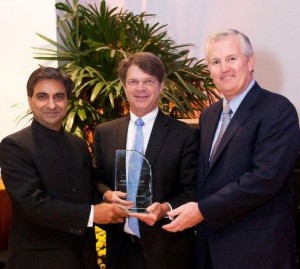
PNC’s Executive V.P. Anuj Dhanda (L) and Chief Financial Officer Rick Johnson (R) with the Green Heart Award with Phipps’ Richard Piacentini (C).
India is not new to Phipps. In 2003, it organized Medicinal Plants of India exhibit; and currently it supports two botanists’ work in India through its Botany In Action program.
Unfurling the details of the Tropical Forest India, Phipps’ Executive Director Richard Piacentini said, Phipps horticulturalists and education experts spent considerable time traveling in India’s Western Ghats to ensure that the exhibit will be the finest. From February 2012 thru January 2015, Phipps’ Tropical Forest Conservatory will transform into India’s Tropical Forest. The exhibit will host public events on the plants, cultures and people of India – all against a lush backdrop of India’s plants and trees.
The evening began with the annual Green Hearts Award presented to the Heinz Endowments and PNC Financial Services Group for “their commitment and leadership roles on environmental issues.â€
Phipps’ Piacentini, making the award to the Heinz Endowments, said, the Heinz Endowments help develop solutions to regional community challenges that are national in scope, He added “Phipps has worked with the Heinz Endowments over the years in the sustainability movement that Teresa Heinz launched here locally in the 1990s.â€
Making the award for the PNC Financial Group, he said PNC has more newly-constructed “green†buildings certified by the U.S. Green Building Council than any company in the world, adding “as Pittsburghers, we’re all anxiously awaiting PNC’s new green sky-rise office tower downtown. Phipps is proud to call PNC a partner in our many programs and plans for the future.â€
The 800,000 sq. ft. 40-storey PNC headquarters to be built at a cost of $400 million, will be completed in 2015. This will be the world’s most ecofriendly corporate headquarters. The 150-year old PNC Group has 60,000 employees nationwide.
The Heinz Endowments President Bobby Voigt, and PNC’s Executive Vice President Anuj Dhanda and Chief Financial Officer Rick Johnson received the Green Heart Awards from Phipps’ Piacentini.
Towards the end, Nita Wadh- wani introduced the audience to flavors of India’s classical and contemporary dances. Kala Niketan’s Soumya Rajupet, and Nandanik Dance Group’s Aparna Roli Nigam, Roosha Mandal, and Vishmaya Saravanan rendered short dance pieces in the Indian classical styles. Ruby Jain provided a contemporary and glamorous Bollywood piece.
Ajit Ranganathan, with Charan Rajan on the mrdangam, wielded the pleasing bamboo flute and set the atmosphere for the evening. Nita introduced these artistes also to the audience. The piece de resistance of the evening was the ambience of Phipps conservatory itself.
— Photographs by Renee Rosensteel  ï®
Medical Tourism Helps Desperate Patients & Raises Ethical Issues
Posted by admin in January 2012 on December 23, 2011
Dr. Kris Gopal. M.D.,F.A.C.S.     e-mail:   gutcut@comcast.net
Wealthy patients and politicians from developing countries have always traveled, and continue to go to developed countries or to neighboring countries for medical treatment 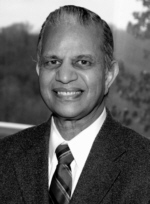 not available in their own countries. Now, a growing number of less-affluent patients from developed countries (North America and Western Europe), in what is called Medical Tourism, travel to regions once pejoratively called the “Third World†for medical treatment. These patients seek, often desperately, medical care that they cannot afford in their own countries.
not available in their own countries. Now, a growing number of less-affluent patients from developed countries (North America and Western Europe), in what is called Medical Tourism, travel to regions once pejoratively called the “Third World†for medical treatment. These patients seek, often desperately, medical care that they cannot afford in their own countries.
Americans are among the estimated 250,000 foreign patients who sought care in Singapore, 500,000 in India and as many as 1 million in Thailand. The cost savings for patients, particularly when the money comes from their own pockets, is huge. See the table below:
Cost of Medical Procedures (in US dollars)
Procedure                US            US           India*     Thailand*     Singapore*
                           Retail   Insurance
Angioplasty             99.000      44,000      11,000     13,000         13,000
Heart Bypass        210,000      94,000      10,000     12,000         20,000
          Heart Valve
Replace (single) Â 274,000Â Â Â Â Â 123,000Â Â Â Â Â Â Â Â 9.500Â Â Â Â Â 10,500Â Â Â Â Â Â Â Â Â 13,000
         Hip Replacement     76,000      31,500         9,000     12,000         12,000
* International rates include airfare, hospital, and hotel. Source: Time, May 21, 2006
In 2006, McKinsey & Co. reported the medical tourism would gross $100 billion by 2012. For most medical tourists, including those from the United States, the reasons for travel are primarily financial. Ease of international travel and improvements in both technology and standards of care in host countries are the other drivers. Services typically sought by travelers include elective procedures as well as complex specialized surgery such as knee and hip replacements, and cardiac, dental, and cosmetic surgery.
Over 50 countries have identified medical tourism as a national industry. Popular medical travel destinations include Argentina, Brunei,
Cuba, Costa Rica, Hong Kong, Hungary, India, Jordan, Lithuania, Malaysia, the Philippines, Singapore, South Africa, Thailand, and recently Saudi Arabia, UAE, South Korea, Tunisia, Ukraine and New Zealand.
Patients unfamiliar with specific medical facilities abroad often coordinate their treatment through medical travel intermediaries who use the Internet to recruit patients. These services work like specialized travel agents. Clients of MedRetreat, for example, can choose from a menu of 183 medical procedures from seven different countries. California based PlanetHospital is a well-known name in this business.
However, perceptions of medical tourism are not always positive. In the US, the medical establishment, which boasts of high quality of care, self-servingly views medical tourism as risky; but offers no alternatives to desperate patients with limited resources.
Till recently it was very difficult to compare the quality of care rendered at various hospitals worldwide. But with the recent accreditation process in Canada and the US, it has become easier to compare results. The accreditation agencies work with hospitals to help them meet standards for patient care and then certify those hospitals meeting the standards.
Companies are beginning to offer global health care options for their employees that will enable North American and European patients to access world health care towards reducing their health care costs. In 2000 Blue Shield of California began the United States’ first cross-border health plan. Patients in California could travel to one of the three certified hospitals in Mexico for treatment under California Blue Shield.
India’s medical tourism sector is expected grow at 30% annually. Foreigners are not likely to face a language barrier in India. India is known for heart surgery, hip resurfacing and other areas of advanced medicine. Surrogate pregnancy in India, which raises lots of ethical issues, is becoming increasingly a popular service.
Medical tourism is not without risks. Potential risks are:
1. Exposure to diseases without having built up natural immunity can be a hazard, as with hepatitis-A, amoebic dysentery, paratyphoid, mosquito-transmitted diseases, influenza, tuberculosis, and others.
2. The quality of post-operative care can vary dramatically.
3. Traveling long distances soon after surgery can increase the risk of developing blood clots in the legs and in the lungs.
4. After returning home, delayed infection is resistant to antibiotics.
5. Hospitals and/or doctors in some countries may be unable to pay the financial damages awarded by a court to patients suing them.
There are other serious ethical/legal issues, too:Â a) Illegal purchase of organs like kidneys and tissues for transplants from gullible, and often poor patients; b) Medical tourism for the classes and health missions for the masses has further deepened the already abysmal inequities, creating two-tier health care in host countries — poor quality care for its own poorer citizens, and better ones for medical tourists. India is a prime example. c) This also creates ethical issues to developed countries. They pretty much abandon their less affluent citizens to fend for themselves while taking care of their affluent/resourceful ones.
A Visit to My Ancestral Village Helped to Get Over My Nostalgia
Posted by admin in January 2012 on December 23, 2011
Samar Sinharoy, Monroeville, PAÂ Â Â Â e-mail: Â samar.sinharoy@gmail.com
It has been sixty three years since my family left what is now Bangladesh after India’s painful Partition in 1947. As an eight-year old boy then, it was exciting to travel with my family to a new place, not being fully aware of the reason for the mass exodus. When we settled down in the seaside town of Puri in India, I liked our new house, new school, the sea, and everything associated with that bustling mid-size town, very different from the village we left behind.
As I grew older, I started remembering our ancestral village, the house, extended family, the trees, ponds, going places with my grandfather, my playmates, festivals, fairs… … Surprisingly, the memories grew stronger as I grew older, and the place I longed to see again. So, when my son-in-law Christopher accepted a teaching position in Dhaka in 2008, I realized that my dream of setting foot in my ancestral village might still come true.
In late August of 2010, during my second visit to Dhaka, my daughter Sheela, aware of my often-expressed desire to visit my ancestral village, suggested I make a day trip to the village located about 120 kilometers north east of Dhakha.
With a driver familiar with the territory, and equipped with my camera, a lunch box and a bottle of water, I took off in a Toyota SUV in the mid-morning in August in search of our ancestral home. It took us over an hour just to get through the northern edge of Dhaka using roads clogged with cycle rickshaws, buses, cars, trucks, push-carts; and with pedestrians forced out on the street by temporary stores set up on the sidewalks. Finally, we were on the open road, on highway AH1. Upon reaching Brahmanbaria, the district headquarters, we took the road to Sarail, a small town adjacent to my ancestral village Kalikaccha. There was now a large army cantonment covering part of both Sarail and Kalikaccha. The driver stopped at the gate and asked the guard if he knew where the Singharoy family house was in the village. The soldier had no idea. The driver kept asking other people, but no one had heard of the Singharoy family.
I was beginning to lose heart. Finally, I remembered a famous revolutionary named Ullaskar Datta from our village, an expert bomb maker, whose bomb was used in the attempted assassination of a British official. I asked the driver to find out where Ullaskar Datta’s house was. He walked into a tea stall where a group of men were sitting around, talking. He returned with a bearded young man wearing a lungi and a shirt, who said his uncle now owned Ullaskar family’s house. He was off from work because this was the Muslim holy month of Ramadan, so jumped into the car guiding us onto the unpaved, dry mud road to his uncle’s house.
Within a couple of minutes, we saw a rickshaw approaching from the opposite direction, with a bearded, middle-aged passenger in typical Muslim garb of pajamas, long kurta, and a white cap. Our guide said, “There comes my uncle.â€Â The rickshaw stopped next to us. Our guide introduced me to his uncle and explained the purpose of my visit. The Uncle told me how happy he was to see me come all the way from America to see my ancestral home. “It must be the pull of the soil,†he said, “but unfortunately, your house is no longer there.â€
He pointed to the rice field and vegetables vines next to the road, and said, “That is where your house and gardens used to be. One of your relatives by the name of Sitesh Singharoy took over the house after the departure of the rest of the family and lived there with his wife and children. He sold the house to a Muslim family during Bangladesh’s struggle for freedom from Pakistan in 1971, and left. The new owners demolished the old house, so only the fields are there for you to see. I wish I could spend more time with you, but I am late for a village council meeting. My nephew will show you around.â€
I was very disappointed that the house I remembered so fondly was gone. It is all green fields now. I wanted to at least walk on the land where my grandfather’s house stood. We got off the car and walked next to the vegetable vines where the house used to be.
Walking around, we came across a large pond. It was called “Jamai hala,†then totally covered with green vegetation. It was cleaned up now and used as a fishery. I looked around to enjoy the idyllic lush greenery all around, with houses barely visible behind trees. The roads were the same dry mud roads I had remembered all these years.
We walked about a block to the house of the revolutionary Ullaskar Datta, now owned by my guide’s uncle. My guide introduced me to his cousin, son of the owner, who said he works in Saudi Arabia, and was home for Ramadan. He welcomed me in to the house, which was in advanced stage of decay, not inhabitable. The family lived in a new addition attached to the old building. After walking around the neighboring areas of the village, we got back into the car and headed back to Dhaka.
What impressed me most about Kalikaccha was how green and peaceful it looked. Life was rather slow paced and people were friendly. I was disappointed by the lack of development. Everything except our ancestral home was just as I remembered as a little boy many years ago.
It was nice to see the village again, but it was not a place where I could ever go back to live. I have finally gotten over my nostalgia. Â ï®
India’s Centuries Old Rebels Against Religious Bigotry
Posted by admin in January 2012 on December 23, 2011
By Kollengode S Venkataraman
The details of the life of Bulleh Shah, the 18th century freethinking Sufi poet of Punjab, are not precisely known. However, scholars have pieced together his life by triangulating the events he describes in his poems with the recorded history of the Mughals and the Punjab. There is consensus that he was born in Bahawalpur in 1680 and died in Kasur in 1757, both places in the Pakistani Punjab today.
In Bulla’s time, the Punjab region was in social, cultural and political turmoil, with Aurangazeb (1658-1707) in Delhi and with armed raids from the west by Nadir Shah and Ahmad Shah Abdali (1747–1773). The Sikhs suffered the most at the brutality of the Mughals and from violent incursions from their western borders. The Sikh’s history is one of the bloodiest in history, and we can not simply gloss over it. They were trying to reassert themselves, even as they were trying to reform the Sikh religion itself.
During this time, Sikhs’ 10th Guru, Guru Gobind Singh (1666- 1708) finalized the document Adi Granth or Granth Sahib, as their non-Corporeal Teacher for guidance on all matters of faith and personal conduct, on which rests today’s Sikh religion.
[A small, but necessary digression: It is necessary here to acknowledge the contribution of the Sikhs to India’s cultural history. There is a popular saying among the Sikhs in the Punjab:  “Khata Peeta Lahe Da, Baaki Ahmed Shahe Da,† literally meaning, “What you eat, drink and wear is yours, the rest is Shah’s.” The Shah the Punjabis refer to are Turkic and Afghani invaders from the West or the Mughal rulers from East from Dilli.  The Shah can be Ghazni, Ghori, Abdali, Nadir Shah or Timur; The Punjab bore the brunt of the these marauders’ raids. My Punjabi friends in Pittsburgh tell me that these invaders from their Western border a few centuries ago will harass the Punjabis men and women on their way to Delhi for their loot. And then, these marauders on their way back from Delhi, will once again harass and loot them on their way back. The Sikhs’ resistance to the Mughals (and other invaders) was persistent all through the centuries.  Even the mighty Mughals simply could not take their minds off the Sikhs on their Western front. This greatly helped India to preserve its pre-Islamic culture to varying degrees. The farther you go from Delhi towards east and south, the better is this preservation that we can see in old Chola-, Pallava-, Chalukya-, and Kakatiya-period temples that still stand and being worshipped in today’s Odisha, and throughout Southern India; and in the way performing arts (Odissi, Bharatanatyam and its derivatives, Karnatic Music, Keertan traditions … …) are preserved with very little influence from the Mughals. So, on this point, people living South of the Vindhyas owe a big Thank You to the Sikhs. ]Â
The well-documented violent strife in Mughal India was not only between Muslims and the Sikhs/Hindus in matters of faith, but also between Shia and Sunni Muslims for political control. The religious turmoil spilled over every facet of life. In this environment, probably because of the bigotry and fights over religious dogma and control, spiritual mysticism of the Sufis sprouted among Muslims. According to K S Duggal*, the Indian version of Sufism integrated elements of Islam, with the native Vedantic ideas and India’s Bhakti Movement.
* http://www.apnaorg.com/poetry/bullahn/Untitled/untitled.html
Growing up and living in this era, Bulleh Shah was disillusioned with the religious bloodletting as we see in this translation of his verse:
Going to Makkah is not the ultimate, even if hundreds of prayers are offered.
Going to Ganga is not the ultimate, even if hundreds of cleansings are done.
Going to Gaya is not the ultimate, even if hundreds of worships are done.
O Bulleh Shah, the ultimate is, when the “I†is removed from the heart!
The “I” the Bullah refers to is our ego.
In India’s “deep†south lived Shiva-vakkiyar in the Tamil country a few centuries before Bulleh Shah (14th century or earlier). Shiva-vakkiyar uses even harsher language against the religious orthodoxy in the context of the discord between the Vaishnavites and Saivites in his time. Here is an example of Shiva-vakkiyar’s alliterative, rhyming and easy flowing verse for those who can read Tamil.
Here is the non-literary translation:
Your God and our God — Really two are there?
Is not the Primordial One here, there, and everywhere?
When the Primordial One is here, there, and everywhere,
Let them rot and perish, those who differentiate!
So, the outpourings of the Free Spirits everywhere are to be seen in the time, place and context of their lives. In Bulla’s Punjab, Mughal rulers were trying to impose Islam – in any case, their version of Islam — on the Hindus and Sikhs against their will. Bulleh Shah’s disillusionment comes out clearly in the following lilting verse given in the Gurumukhi script for those who enjoy reading it in its original :
Translation:
Neither Hindu nor Muslim; giving up pride, let us sit together.
Neither Sunni nor Shia, let us walk the road of peace.
We’re neither hungry nor full, neither naked nor fully clad.
Neither weeping nor laughing, neither ruined nor settled.
We are not sinners, nor virtuous,
What is sin and what is virtue, this I do not know!
Says Bulla, “One who attaches his self with Hari*
Gives up both Hindu and Muslim.â€
* Important Note: Hari, the term often used by Kabir, Bulla, and many other Hindu/Sikh poets refers to the nameless, formless, all-pervading Infinite One (or nirguna brahman in Sanskrit), and is not limited to the Puranic Hari.
If Bulleh Shah or Shiva-vakkiyar were in today’s US, in all likelihood, they would have composed liltingly alliterative verses needling those Yahudis (Jews) and Issais (Christians) like Kentucky’s Republican David Williams and Alabama’s Republican Gov. Robert Bentley and others, who claim exclusive pathways in mankind’s spiritual quest.
Acknowledgment: Ms. Manjit Kaur & Mr. Surinderjit Singh of Monroeville and Mr. Anterpreet Singh of Punjabi Kavita website for their help in getting Bulleh Shah’s verse in the Gurumukhi script.  ï®
Interfaith Marriages is Part of Our Life Here — Let Us Accept it!
Posted by admin in January 2012 on December 23, 2011
By Dilip Amin, San Francisco, California
e-mail: dilipamin@yahoo.com      www.InterfaithShaadi.org
Dilip Amin is a scientist, former president of Plymouth Balvihar in Pennsylvania and a parent of two young adult children. He is passionate about educating people about interfaith marriages, has written fifteen articles, and co-authored a book.
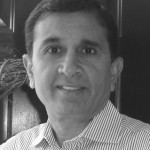 In the Western world, young adults date someone from other faiths during their college years. Therefore it should come as no surprise that in North America about a third of our young generation of Hindus (Jains and Sikhs as well) marry Christians, Jews and Muslims (Abrahamics). This trend is expected to rise in the years ahead.
In the Western world, young adults date someone from other faiths during their college years. Therefore it should come as no surprise that in North America about a third of our young generation of Hindus (Jains and Sikhs as well) marry Christians, Jews and Muslims (Abrahamics). This trend is expected to rise in the years ahead.
There is often a large gap between the expectations of Hindu parents and their children about the child’s choice of a life-mate, at least initially. Thus, where an Abrahamic life partner is selected, frequently, Hindu young adults decide without pre-emptive advice, guidance, or consultation with their parents.
It is safe to say that most Hindus are not sufficiently knowledgeable about the Abrahamic faiths and how they differ from the Hindu dharma. So, often they are not well equipped to guide their young adults in this critical transition, resulting in irrational arguments in homes.
In the predominantly first generation immigrant Hindu community, some parents whose child has not married yet, may smugly look at others whose child has a non-Hindu spouse without realizing that it could happen in their own home a few years down the road.
Interfaith marriages, we need to recognize, are a matter of chance, and do not necessarily reflect the Hindu religious training given in childhood. On the other side, parents with interfaith marriages in their homes are reluctant to share their experience of interacting with Abrahamic in-laws, resulting in loss of knowledge for the benefit of our community.
One of the critical questions that has to be addressed in any interfaith relationship is: What will be the religion of the children by this marriage? A Hindu must ask: Is there any expectation of religious “label†to be placed on the child(ren) by Baptism (Christian), Bris (Jewish) or Sunat (Islamic)?
Some other issues to address are: a) expectation of religious conversion of the Hindu groom/bride before marriage; b) first names of children; c) son’s circumcision for religious reason even though there is no medical consensus for recommending the procedure; and d) any reservation by the Abrahamic spouse to be a part of Hindu worship practice of pooja and the display of Hindu Ishwara icons in home. And finally, also on funeral rites of the non-Abrahamic spouse and children by this marriage.
Baptism, Bris or Sunat as a ritual is not an issue, but the thought process behind asking for it should be a concern. The Bible states more than thirty times that Lord their God is a Jealous and Angry God and will not tolerate praying to “other gods.†Are Lord Krishna and Goddess Laxmi other gods? Further, Christianity teaches that only their faithfuls will achieve salvation, and others will be condemned to hell on the Judgment Day, after the Second Coming of Christ in the future. Islam too has similar teachings. Does it mean Mahatma Gandhi will go to hell?
Not all Abrahamics impose their religious beliefs/practices on their non-Abrahamic spouses, but it is critical to find out facts sooner than later.
It is also important to recognize that despite all the potential marital pitfalls, a successful and fulfilling inter-religious marriage is possible. One effective way to achieve this is by not imposing one’s religious beliefs on the other partner.
America on Sale
Posted by admin in January 2012 on December 23, 2011
By Ashok Madhav, Penn Hills, PAÂ
 Americans are a generous bunch – I mean the American business especially. Take a walk in any mall. You see Sale signs practically on every store window — be it a store for garments, computers, furniture, jewelry, shoes, toys… The common signs are “20-50% Off Sale Price†or “50% off of Already Marked Down Prices.†Another is “Buy one and get the other one free or half off.†America on Sale
Americans are a generous bunch – I mean the American business especially. Take a walk in any mall. You see Sale signs practically on every store window — be it a store for garments, computers, furniture, jewelry, shoes, toys… The common signs are “20-50% Off Sale Price†or “50% off of Already Marked Down Prices.†Another is “Buy one and get the other one free or half off.†America on Sale
Sometimes we come across signs like this: “All items 70% off for limited time only.†Occasionally, this sign: “This is One Day Sale Onlyâ€, which I’ve seen hanging on the window for several days in a row.
Sales for special days like President Day, Easter, Memorial Day, Christmas, just to name a few, are always attractive. One does get good bargains on clothes, toys, chocolates and other goodies.
If a business is giving anything for 70% off the sale price, think of the mark up on those items. Much of the items are imported from the wretched Third World from places like Nicaragua, Honduras, Mexico, Sri Lanka, Bangla Desh… … at a fraction of the price sold in the American outlets. China, the biggest producer of all kinds of consumer goods, supplies 70% of the merchandise to Walmart, world’s largest retail store.
We, including our politicians, buy these products and support outsourcing of jobs from the USA. Often, even the “Buy American†signs and are made in Red China. But the issue of outsourcing is nice topic for politicians to talk about and get the votes for themselves.
The bottom line for all of us is to save as much as possible and get the maximum benefit. This reminds me of a cartoon, where wife tells her husband, “Honey, today I saved quite a bit of money by buying my dress, a hand bag and a pair of shoes. I wanted to save more but I ran out of money†!!!                       n
Ha, Ha, Ha!!!
Posted by admin in January 2012 on December 23, 2011
(Newt) Gingrichian Ideas/Thoughts in His Own Words
  “[We need] a massive new program to build a permanent lunar colony to exploit the Moon’s resources.â€
 “[We need] a massive new program to build a permanent lunar colony to exploit the Moon’s resources.â€
“[A] mirror system in space could provide the light equivalent of many full moons so that there would be no need for nighttime lighting of the highways.â€
“We should replace bilingual education with immersion in English so people learn the common language of the country…†Two years later, Gingrich unveils a new Spanish-language website, The Americano
“It doesn’t matter what I do. People need to hear what I have to say. There’s no one else who can say what I can say.â€
“Gingrich’s Primary mission — Advocate of civilization, Definer of civilization, Teacher of the rules of civilization, Leader of the civilizing forces.â€Â – Newt on himnself.
“I have enormous personal ambition. I want to shift the entire planet. And I’m doing it. I am now a famous person. I represent real power.â€
“I’m not a natural leader. I’m too intellectual; I’m too abstract; I think too much.â€
“The idea that a congressman would be tainted by accepting money from private industry or private sources is essentially a socialist argument.â€
“You can’t trust anybody with power.â€
================================
Jon S. Corzine is the former CEO of Goldman Sachs, New Jersey’s one-term former Democratic U.S. senator and its Democratic ex-governor. His earnings in Goldman Sachs was in several hundreds of millions of dollars.  When Corzine was the CEO of the commodities brokerage firm MF Global, it precipitously collapsed and became bankrupt in October 2011.  Over $1 billion of  MF Global’s account holders’ monies were missing, for which US Congress held hearings.
In testimony to a Congressional committee in December Corzine said he was “stunned†to learn shortly before MF Global became bankrupt last October that MF Global could not account for the money, estimated to be $1.2 billion.
He said,“I simply do not know where the money is,†all the $1,200,000,000 of it.
Is there any wonder why people hold politicians and Wall Streeters in such contempt?Â
================================
We do not enjoy pleasures — we are only consumed by them.
We do not observe austerity — it brands us instead.
Time does not pass — only we are passing.
Cravings do not wear away — only we are worn out.
 — Bhartrhari, the famous Sanskrit poet  (7th century or 5th century AD)

